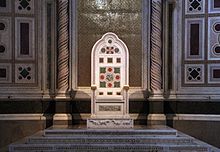Holy See
![]()
This article is about the subject of international law. This article is not to be confused with the Vatican City
The Holy See (Latin Sancta Sedes "holy see"), also Apostolic See (Latin Apostolica Sedes), Pontifical See or See of Peter, is the episcopal see of the Diocese of Rome. As a non-state sovereign power, it forms a separate subject of international law and represents the Vatican City State and the Roman Catholic Church in international relations. In addition to the Pope as personal representation, the Holy See also includes the administrative institutions of the Roman Curia.
The links between the Holy See, Vatican City, the papacy and the Roman Catholic Church are far-reaching and not always clearly distinguishable. In colloquial usage, the Vatican usually refers to the Holy See or its administrative bodies.
The term chair derives from the bishop's cathedra, a symbol of the authority of a public official handed down since antiquity. The episcopal see in Rome is traced back to the legendary founding of a first Christian congregation by the apostle Peter, which is why it has a special position in all of Christianity (papal primacy, pentarchy). In the early Church, the term holy see was used synonymously with episcopal see for any episcopal see; only later did it focus on the particularly significant Roman episcopal see, and since the 19th century has been used almost exclusively to refer to it.

The namesake Holy See (Cathedra of the Pope in the Lateran Basilica)
History
Apostolic points to the connection to the apostles appointed by Jesus, following him. The origin goes back to the New Testament: "You are Peter, and on this rock I will build my church ..." Gospel of Matthew (16:18 EU). The apostolic see was initially understood to be all the episcopal sees that were in direct apostolic succession. Among them, Alexandria, Antioch, Jerusalem and Rome had a primacy as patriarchal sees. Besides Rome, only the diocese of Mainz still bears the designation Holy See.
See also: List of Popes
This view was later used for the Roman episcopate. As a result, the Apostolic See became more and more associated with the succession of Peter and his successors as bishops of Rome (Sedes Apostolica Romana). In the 7th century, the term ecclesia universalis (universal church) focused more and more on the ecclesia romana (Roman church), thus limiting itself to the occidental expression. Since Pope Damasus I (366-384) the conviction developed that only the bishop of Rome could claim to sit on the Holy See of Rome. With Pope Siricius (384-399), the sole title of Pope solidified to that of Bishop of Rome. From this, with Pope Leo I the Great (440-461), the title Vicarius Christi arose in succession, placing the Holy See in Rome on an equal footing with the Roman Empire.
The diocese of Rome extends beyond the borders of the Vatican City State into Italy, and the Pope is the bishop of this Holy See.
The Holy See in International Law
The Holy See in the person of the Pope (identity in the sense of canon law and international law) is completely sovereign and, according to widespread international law doctrine, is regarded as an original, non-state subject of international law. In international law, this is currently the only case in which a natural person, in his official capacity by virtue of his office and for the duration of that office, is accorded subjectivity under international law that is not derived from any superior legal subject under international law (apart from the Grand Master of the Order of Malta). This distinguishes the Pope from an ordinary head of state who acts for a subject of international law but is not himself a subject of international law. The reason for this situation is that with the end of the Papal States, the Holy See was not to be left without this status, and after the recognition of the Vatican as a residual ecclesiastical state, this dual sovereignty in international law has remained.
The Holy See is not identical with the Catholic Church, which is a separate legal subject. The Catholic Church itself is not a subject of international law, but the Pope, or rather the Holy See, represents it externally as head and can thus defend its interests in diplomatic dealings.
Questions and Answers
Q: What is the Holy See?
A: The Holy See is the office of the Bishop of Rome, which is also known as the Pope.
Q: What does the term Holy See also mean?
A: The term Holy See also means the Pope and the Roman Curia, the central government of the Roman Catholic Church.
Q: Are all episcopal sees considered holy?
A: Yes, every episcopal see is seen as holy.
Q: Which church constantly applies the adjective "holy" or "sacred" to all of its sees?
A: The Eastern Orthodox Church constantly applies the adjective "holy" or "sacred" to all its sees.
Q: What does "the Holy See" normally mean?
A: "The Holy See" normally means the see of Rome which is also called the Apostolic See.
Q: What is the significance of the term "Apostolic See"?
A: The term "Apostolic See" is used to refer to the see of the bishop seen as the successor of the chief of the Apostles, Saint Peter.
Q: Aside from Rome, is there any other Western see that bears the title of "Holy See"?
A: Yes, aside from Rome, the archiepiscopal See of Mainz, which was also of electoral and primatial rank, is the only other Western see that bears the title of "Holy See", although this usage is less common.
Search within the encyclopedia